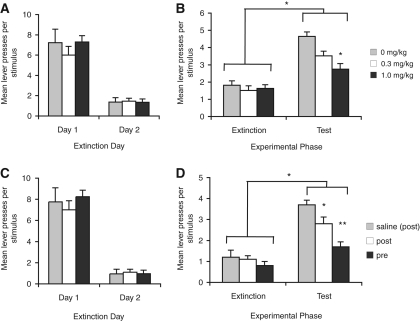Figure 3.
Atomoxetine treatment enhances extinction. (A) Mean lever presses per stimulus for the initial extinction sessions for Experiment 3A. (B) Mean lever presses per stimulus during the final extinction session containing the drug treatments and during the test session conducted drug-free 4 wk later. Treatment with atomoxetine had no effect on responding (F(2,33) = 0.9, P > 0.05); however, when rats were tested for spontaneous recovery of responding 4 wk later, while all groups showed an increase in responding, this effect was greater in the group treated with saline than in those treated with atomoxetine (F(2,33) = 5.7, P < 0.01), indicating that atomoxtine treatment enhanced extinction. *Indicates a significant difference in the number of lever presses; P < 0.05. N = 12, 10, and 13 for the saline, 0.3, and 1.0 mg/kg groups, respectively. (C) Mean lever presses per stimulus for the initial extinction sessions for Experiment 3B. (D) Pretraining atomoxetine reduced spontaneous recovery to a greater extent than post-training treatment. This statistical analysis reveals an effect of experimental phase, indicating that responding for all groups was higher at test than in extinction (F(1,2) = 67.7, P < 0.001). There was also an effect of group (F(2,21) = 7.8, P < 0.01), but no interaction between these factors (F(2,21) = 2.2, P > 0.05). Simple effects analyses of the test session indicate an effect of group (F(2,21) = 7.6, P < 0.01) and post-hoc analyses indicate that both pretraining and post-training groups responded less at test than those treated with saline and that the pretraining group showed less spontaneous recovery than the post-training group. *Indicates a significant difference from saline; **from saline and post-training groups. N = 7, 10, and 7 for the saline, post-training, and pretraining groups, respectively.

